Today Perm designers and technologists work in four major areas. The first is the launch of a large PD-14 certified in October last year and the creation of a family of aircraft engines and industrial turbines on its basis. The second is the design and preparation of capacities for the production of the PD-35 ultra-large turbofan motor. Third, expansion of production of existing and promising gas turbines, mainly in the interests of the oil and gas sector. Fourth, ensuring the uninterrupted operation of the fleet of MiG-31, Tu-134, Il-96, Tu-204 and MC-21 aircraft for the entire period of operation, by creating a modern repair base for their power plants.
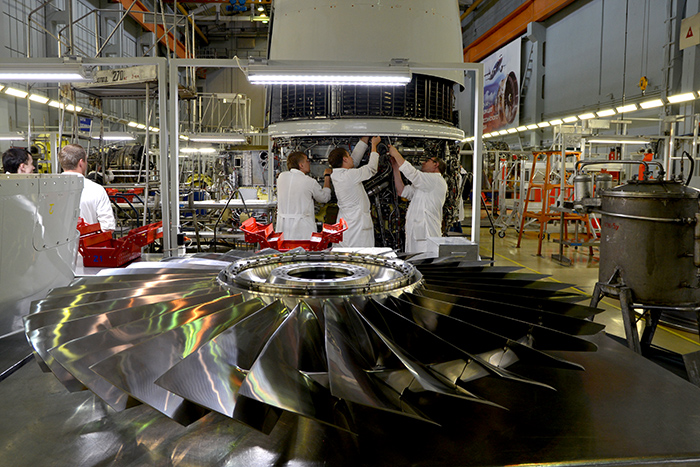
PS-90 in the assembly shop
In addition, according to Sergey Popov, Managing Director of UEC-Perm Motors, as part of the distribution of work among enterprises of the United Engine Corporation (UEC), UEC-PM implements programs to create two centres of competence - to manufacture single-crystal blades for a wide range of engines and shafts for all gas turbines in the corporate line. In particular, next to the foundry producing blanks for blade machines, a new machining workshop with a total area of 12 thousand square meters will be erected. The development of relevant documentation will take the rest of the current and part of next year, and construction will be completed in the summer of 2022. And as part of the extensive PD-35 program, UEC-PM creates the necessary production base, including on the territory of a suburban station, where today the newly assembled PS-90A and PD-14 are being tested on open and closed stands.
Specifically, for application on the MC-21-300, the new PD-14 engine is certified, and for the shortened MC-21-200, the PD-14A “throttled” in thrust from 14 to 12.54 tons is designed. An extended MC-21-400 with a larger wing will receive PD-14M with a thrust of 15.6 tons. A longer-range aircraft - PD-16 increased bypass with a corresponding value in the range of 17.5-17.6 tons of thrust.
The largest in the lineup with a thrust of 18.7 tons (+ 33.5% to the base PS-14) will be the PD-18R with a reduction gear between the turbine and the compressor. The latter promises an extremely low specific fuel consumption - at the level of 0.506 kg / kgf * h (+ 4%). This is lower than that of the closest competitors in traction class: the PW1000 line of Pratt & Whitney (USA) and LEAP-1 of CFM International (USA and France). Such a motor can be created within five to six years from the moment the corresponding program is launched. Probably, the PD-18R will suit the new Medium Military Transport Aircraft (SVTS), in the competition for the best project of which Ilyushin and Tupolev participate. In addition, in the future, it is possible to remotorize IL-476 aircraft on PD-16 or PD-18R (both are in the dimension of the existing PS-90A76) and SSJ100 on PD-10 (PD-7/8).
On the IL-96-400M early production, PS-90A3 engines (version PS-90A2 certified in 2010) and an improved version PS-90A3M were offered. However, aircraft builders opted for the time-tested PS-90A1, with which cargo IL-96-400Ts are equipped. Then there will be a twin-engine version with the PD-35 being developed. The same motor is quite suitable for the promising wide-body CR929. According to the calculations of experts from the Middle Kingdom, the new machine will require 34.8 tons of take-off engines.
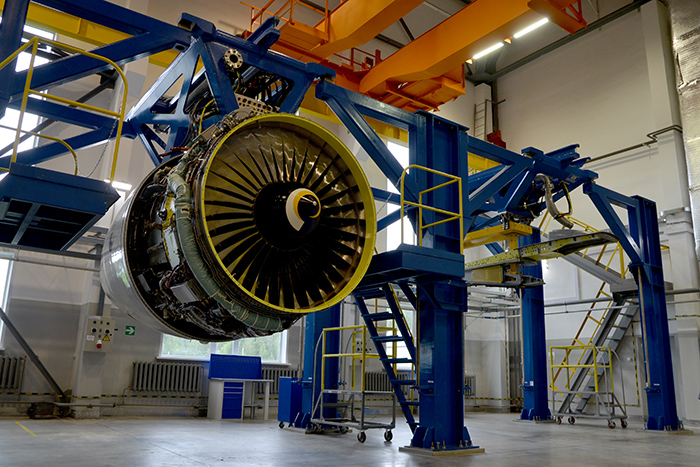
PS-90 at the test station
Note that the Chinese are developing their own AEF3500 engine for this aircraft, first introduced as a 1: 2 scale model and individual compressor components at Airshow China 2018. However, the AECC developer company does not have sufficient experience in developing turbojet engines for passenger aircraft. In the meantime, the main C919 (156-174 seats) and the regional ARJ-21 (70-105 seats) are equipped with western LEAP-1C and CF-34, respectively. First shown at the Beijing Civil Aviation Exhibition in 2011 as a large-scale copy, the CJ-1000A engine, according to local experts, “failed.”
Perhaps, for this reason, there is interest in the use of PD-14 on the C919. A realistic option would be if two conditions are met. The first is that the fees and restrictions on trade between the PRC and the USA, intensely introduced by the White House, will intensify up to the ban on the export of American engines. The second - “Aviadvigatel” will “validate” the type certificate for PD-14, and UEC-PM - certification of its production for compliance with the requirements of the European Aviation Safety Agency EASA.
As Perm colleagues explained to us, obtaining European approval for PD-14 is carried out in two independent areas. Aviadvigatel is trying to get approval (recognition) of the Russian type certificate in 2020. Moreover, without additional tests, since the developer “took into account all their requirements” during the design and testing. This process is called "validation." General Designer Alexander Inozemtsev even sometimes uses the term “shadow certification”. It first appeared in relation to the IL-96-400T at the end of the last century, when the machine received the approval of the US Federal Aviation Administration (U.S. FAA). Meanwhile, recently, engine builders received through the Ministry of Industry and Trade a three-year state contract to improve the PD-14 with a view to its full compliance with the new requirements of the aviation authorities.
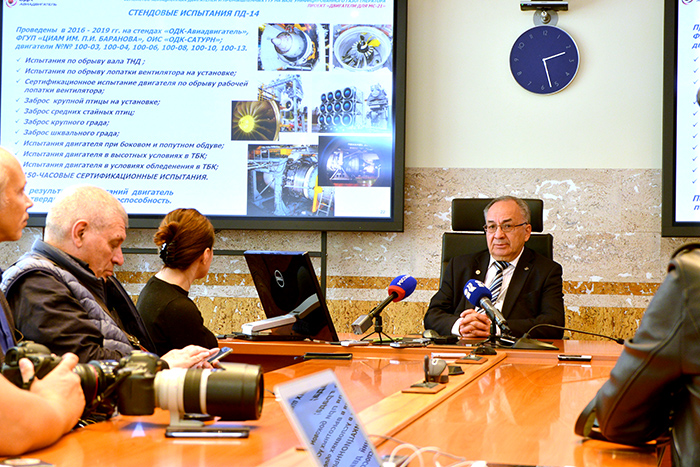
General Designer of JSC UEC-Aviadvigatel Alexander Inozemtsev
For its part, UEC-PM is making efforts to certify the production of PD-14. It has already been received from Russian structures (Litera O1 in 2018). EASA Factory workers turned last year. It took several months to compile and translate the required documentation from Russian into English. The Europeans conducted their first two-week audit in March of this year. The volume of inspections turned out to be very large, and was carried out at a more serious level than that used in the practice of domestic state regulators. A number of comments were made that need to be addressed, which is now being done. The next round is scheduled for October. Final inspections are recorded for the spring and summer of next year. The culmination of the process will be the receipt of the desired document in the second half of 2020.
Airbus representatives also visited Perm. They asked for a meeting shortly after the news of PD-14 certification in order to get to know the status of the program. The main attention was paid to the state of affairs with the production of serial production at UEC-PM. The guests were shown a workshop and a test station with ready-made engines for the third flight MС-21 (with numbers 14, 15 and 16) stored there at that time. Formally, they were handed over to Irkut in December, but left in safe custody until the machine reaches a certain level of readiness. Permians would be happy to sell serial products to the West, but do not believe in this opportunity for political reasons. “The Americans will die, not letting us with our motors into their markets. And you can always come up with a reason for sanctions. The point here is not Ukraine, Salisbury and other pretexts, there is just a tough competition, and any measures of state protectionism are applied, ”says Alexander Inozemtsev.
The workshop, where the PS-90A and PD-14 are assembled, employs 362 employees, including 75 in the PD-14 section, including 25 qualified assemblers. The capacity of the workshop is seven engines per month, the assembly cycle is from 14 to 22 days, depending on the number of additional sensors and other things, which is important for motors going for testing. The power of the PD-14 section is 12 engines per year, which “in fact” is 24, since the first copies undergo a “double assembly cycle”. The complexity of the assembly of the serial PD-14 will be significantly lower than the PS-90. So, the number of pipelines was reduced by half - up to 250. In addition, the load on the workshop was reduced by supplying ready-made modules from related companies: gearboxes for cooperation with MMPP Salyut, low-pressure compressor (LPC) with NPO Saturn, high pressure compressors (HPC) and low pressure turbines (HPH) - from the Ufa MPO. Compared to PS-90, the degree of localization of production at UEC-PM is reduced from 70-80 to 40-45%. The total number of external suppliers is 120.
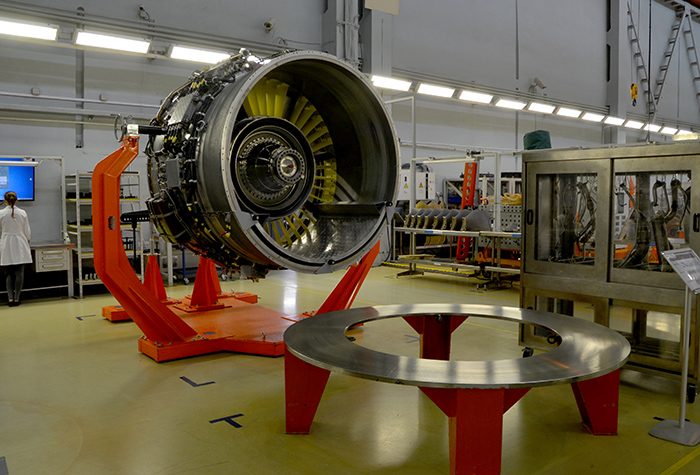
PD-14 in the assembly shop
In mid-August, completion was completed and the final assembly of PD-14 engines with numbers 17 and 18 began. They are intended for the second flight MС-21 in the version with PD-14. Their transfer to Irkut is planned for the 1st quarter of 2020. The next motor No. 19 will be the first intended for a production aircraft, which will go into commercial operation. Note that while the capacity of the assembly shop significantly exceeds the factory, which is four PD-14 per year. According to the current plan, in five years it will increase to fifty.
As of mid-August, engine number 14 was in the workshop. It was retrofitted with the installation of additional units for new tests. This copy is designed for mounting on the left wing. Its “understudy” - with number 15, it has significantly fewer additional sensors. Motor number 16 is used as a backup for the first MС-21 / PD-14. Perhaps motor No. 14 will be subjected to additional tests according to the new ICAO requirements - resistance to the ingress of a flow of solid non-volatile particles (volcanic activity).
In total, 13 motors were assembled for the test program, the first pair being on the Aviadvigatel, and all subsequent ones on the UEC-PM. This has reduced the preparation time for serial production. The documentation was transmitted digitally. PD-14 was the first Perm engine, completely made using paperless technology "in numbers", including document management. For this, 2600 workplaces at Aviadvigatel are equipped with computers, and at OEC-PM daily contact with the developer via digital channels is carried out by about 400 technologists.
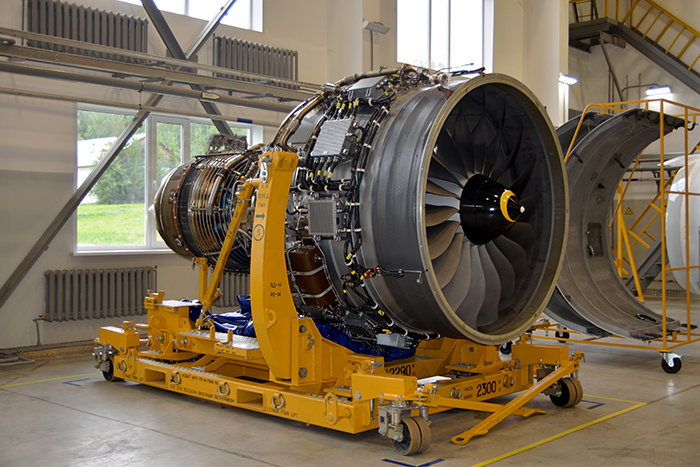
PD-14 at the test station
Flight tests are conducted at the IL-76LL flying laboratory, on one of the four pylons of which PD-14 is installed instead of the standard D-30KP. Two engines were sequentially involved with numbers 7 and 11. To date, they have worked 270 hours under the wing of the aircraft, including 200 in the air. Now IL-76LL is being prepared for the third test cycle.
To obtain permission to start flight tests of the MС-21, a proven resource of 500 cycles is sufficient. By the time of delivery of the airline’s cargo aircraft, which is expected in the second half of 2022, the figure should be increased to 7500. So far, Irkut has ordered only five engines for UEC-PM - two for each of the two prototypes and one reserve. Certification MС-21 / PD-14 is planned by mid-2022. According to the calculations of Perm, they beat PW1500 at the cost of a flight hour of 3-5%. Fuel consumption is slightly higher, but the PD-14 has fewer blade stages, which means it is easier and faster to service on the ground.
In parallel, system work is underway to create infrastructure, including customer support centres and repair stations. From next summer, through the Ministry of Industry and Trade, budget financing is allocated to it until 2030 with a total volume of 36 billion rubles, adjusted for the real number of aircraft from operating organisations. Among other things, it will be used to create a pool of replacement engines, spare parts warehouses. One of the support centres will be located in the Moscow air hub. In a word, the latest Russian airliner will have not only a competitive domestic power-plant, but also a powerful ground base to ensure its uninterrupted operation.
The certification program included a 150 hour continuous hot test cycle. The total operating time on ground stands is more than 2600 hours. Most of them are powered by motor No. 12, including tests for 1,500 take-off and landing cycles completed last month. They were divided into two stages, 500 and 1000 cycles. The possibility of safe running of 1500 cycles before carrying out heavy maintenance has been confirmed. The following goals are two and then five thousand cycles. As a rule, the cycle is taken to start and run the engine for ten minutes, including two on takeoff mode.
Comparative data of current turbojet engines for civil aviation
|
engine's type
|
CFM-56-7
|
CFM-56-5
|
LEAP-1B
|
LEAP-1A
|
PW1400G
|
SaM.146
|
PS-90A1
|
PS-90A2
|
PD-14
|
|
Developer and manufacturer
|
CFM International (USA and France)
|
CFM International (USA and France)
|
CFM International (USA and France)
|
CFM International (USA and France)
|
Pratt & Whitney (USA)
|
PowerJet (France and Russia)
|
"Aircraft engine"
"UEC-Perm Motors"
|
"Aircraft engine"
"UEC-Perm Motors"
|
"Aircraft engine"
"UEC-Perm Motors"
|
|
Take-off thrust, tons
|
12,38
|
12,25
|
12,66
|
14,92
|
14
|
7,9
|
17,4
|
16
|
14
|
|
Fan diameter, m
|
1,613
|
1,735
|
1,763
|
1,98
|
2,057
|
1,224
|
1,9
|
1,9
|
1,9
|
|
Bypass Degree
|
5,1
|
5,7
|
8.5
|
11
|
12
|
4,4
|
4,5
|
4,5
|
8,5
|
|
Degree of pressure increase
|
32,7
|
32,6
|
43
|
45
|
45
|
28
|
38
|
39,6
|
41
|
|
The temperature at the entrance to the turbine, deg. Kelvin
|
|
|
|
1830
|
1820
|
1610
|
1640
|
1718 (before 1800)
|
1760 (up to 1800)
|
|
Specific fuel consumption, kg / kgf * h
|
0,62
|
0,6
|
0,53
|
0,51
|
0,51
|
0,629
|
0,604
|
0,6
|
0,525
|
|
Dry weight kg
|
2370
|
2380
|
|
|
2858
|
1708
|
3100
|
2950
|
2870
|
|
Supply weight, kg
|
|
3400
|
|
4030
|
4080
|
|
4305
|
4220
|
3970
|
|
Number of compressor stages
|
13
|
14
|
14
|
14
|
12
|
10
|
16
|
16
|
12
|
|
The number of stages of the turbine
|
5
|
5
|
7
|
9
|
5
|
4
|
6
|
6
|
8
|
|
The total number of stages of blade machines
|
18
|
19
|
21
|
23
|
17
|
14
|
22
|
22
|
20
|
|
Start of commercial operation, year
|
2007
|
2007
|
2017
|
2016
|
2016 (GTF on the A320neo and A220)
|
2010
|
Certification 2007, operation by Flight airline since 2011
|
Certification 2009, not mass-produced
|
Certification 2018, start of operation according to plan 2022
|
|
Application
|
Boeing 737NG
|
Airbus A320
|
Boeing 737MAX
|
Airbus A320neo
|
MC-21-300
|
SSJ100
|
IL-96-400Т
|
Designed for Tu-204SM
|
MC-21-300
|











